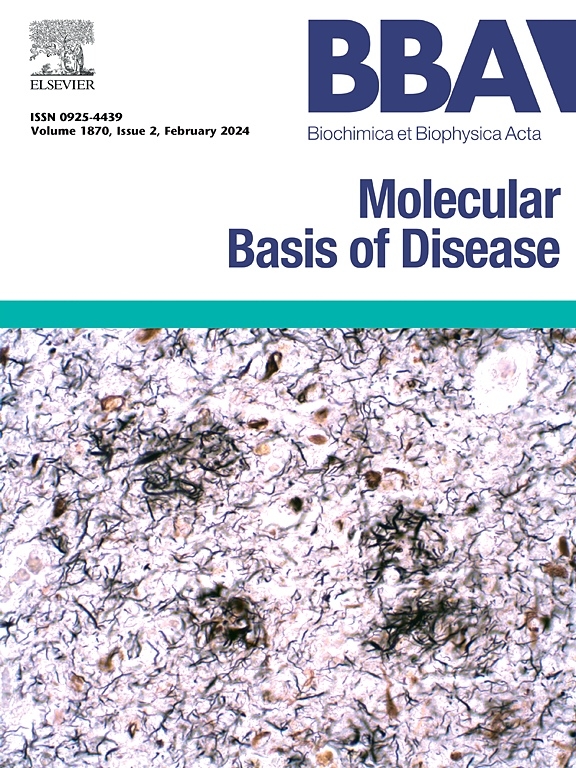Pathological forms of TDP-43 in amyotrophic lateral sclerosis (ALS) promote aberrant telomere elongation
IF 4.2
2区 生物学
Q2 BIOCHEMISTRY & MOLECULAR BIOLOGY
Biochimica et biophysica acta. Molecular basis of disease
Pub Date : 2025-05-14
DOI:10.1016/j.bbadis.2025.167906
引用次数: 0
Abstract
Amyotrophic lateral sclerosis (ALS) is a neurodegenerative disorder affecting motor neurons. TAR DNA-binding protein 43 (TDP-43) mis-localisation from the nucleus to the cytoplasm is the major pathological characteristic of ALS. Telomeres are repetitive DNA sequences found in complex with proteins at chromosomal ends. The shelterin protein complex protects telomeres from DNA damage by producing characteristic t-loop structures, and telomere repeat binding factor 2 (TRF2) has an essential role in this process. Telomere dysregulation is reported in ALS, but conflicting findings have been obtained. Here we examined if telomere dysregulation is present in cortical neurons in a mouse model with pathological mis-localisation of TDP-43 to the cytoplasm - TDP-43 rNLS - compared to controls, and in cortical primary neurons expressing TDP-43 ALS associated mutations (A315T, A90V). We demonstrate that telomeres are significantly longer and of more variable in length in the TDP-43 rNLS model compared to controls. This was proceeded by downregulation of TRF2 in early disease stages with subsequent upregulation of TRF2 at advanced disease in TDP-43 rNLS mice. Longer telomeres were also present in primary cortical neurons expressing mutant TDP-43. A trend towards TRF2 upregulation was also present in human ALS spinal cord lysates. We detected dysregulation of catalytic subunit of telomerase, TERT, and a trend towards upregulation of telomere interacting protein, Rif 1 in these mice and human ALS spinal cord lysates. The longer telomeres were independent of the alternative lengthening of telomeres (ALT) mechanism of maintaining telomere length. Similarly, no DNA damage at telomere sites was detected. Our findings imply that telomere protection is compromised in ALS, leading to longer telomeres in neurons in ALS associated with TDP-43 pathology.
肌萎缩性侧索硬化症(ALS)病理形式的TDP-43促进异常端粒伸长。
肌萎缩侧索硬化症(ALS)是一种影响运动神经元的神经退行性疾病。TAR dna结合蛋白43 (TDP-43)从细胞核错定位到细胞质是ALS的主要病理特征。端粒是在染色体末端与蛋白质复合物中发现的重复DNA序列。庇护蛋白复合物通过产生特征性的t环结构来保护端粒免受DNA损伤,而端粒重复结合因子2 (TRF2)在这一过程中起着至关重要的作用。端粒失调在ALS中有报道,但已经获得了相互矛盾的发现。在这里,我们研究了与对照相比,TDP-43病理性错定位到细胞质的小鼠模型(TDP-43 rNLS)和表达TDP-43 ALS相关突变(A315T, A90V)的皮质原代神经元中是否存在端粒失调。我们证明,与对照组相比,端粒在这个模型中明显更长,长度更可变。这是通过在TDP43 rNLS小鼠的疾病早期下调TRF2,随后在疾病晚期上调TRF2来实现的。在人类ALS中也存在TRF2上调的趋势。我们在这些小鼠和人ALS脊髓裂解物中检测到端粒酶催化亚基TERT的失调和端粒相互作用蛋白Rif - 1的上调趋势。较长的端粒与端粒的选择性延长(ALT)无关。同样,端粒位点没有检测到DNA损伤。我们的研究结果表明,端粒保护受损,导致与TDP-43病理相关的ALS皮质神经元端粒变长。
本文章由计算机程序翻译,如有差异,请以英文原文为准。
求助全文
约1分钟内获得全文
求助全文
来源期刊
CiteScore
12.30
自引率
0.00%
发文量
218
审稿时长
32 days
期刊介绍:
BBA Molecular Basis of Disease addresses the biochemistry and molecular genetics of disease processes and models of human disease. This journal covers aspects of aging, cancer, metabolic-, neurological-, and immunological-based disease. Manuscripts focused on using animal models to elucidate biochemical and mechanistic insight in each of these conditions, are particularly encouraged. Manuscripts should emphasize the underlying mechanisms of disease pathways and provide novel contributions to the understanding and/or treatment of these disorders. Highly descriptive and method development submissions may be declined without full review. The submission of uninvited reviews to BBA - Molecular Basis of Disease is strongly discouraged, and any such uninvited review should be accompanied by a coverletter outlining the compelling reasons why the review should be considered.

 求助内容:
求助内容: 应助结果提醒方式:
应助结果提醒方式:


